LAW 1433-01 - Comprehensive Report on the Indian Criminal Law System
VerifiedAdded on 2023/04/22
|8
|1696
|393
Report
AI Summary
This report provides a comprehensive overview of the Indian Criminal Law System, focusing on the Indian Penal Code 1860, the Code of Criminal Procedure 1973, and the Indian Evidence Act 1872. It delves into the structure of the system, including the roles of the prosecutor (Attorney General), the court system hierarchy (Supreme Court, High Courts, and District Courts), and the types of criminal codes employed. The report also highlights key distinctions between the Indian and Canadian criminal law systems, such as the absence of a jury system in India, the differing stances on capital punishment, and variations in laws regarding attempted suicide. References to significant legal cases and acts are included to support the analysis.
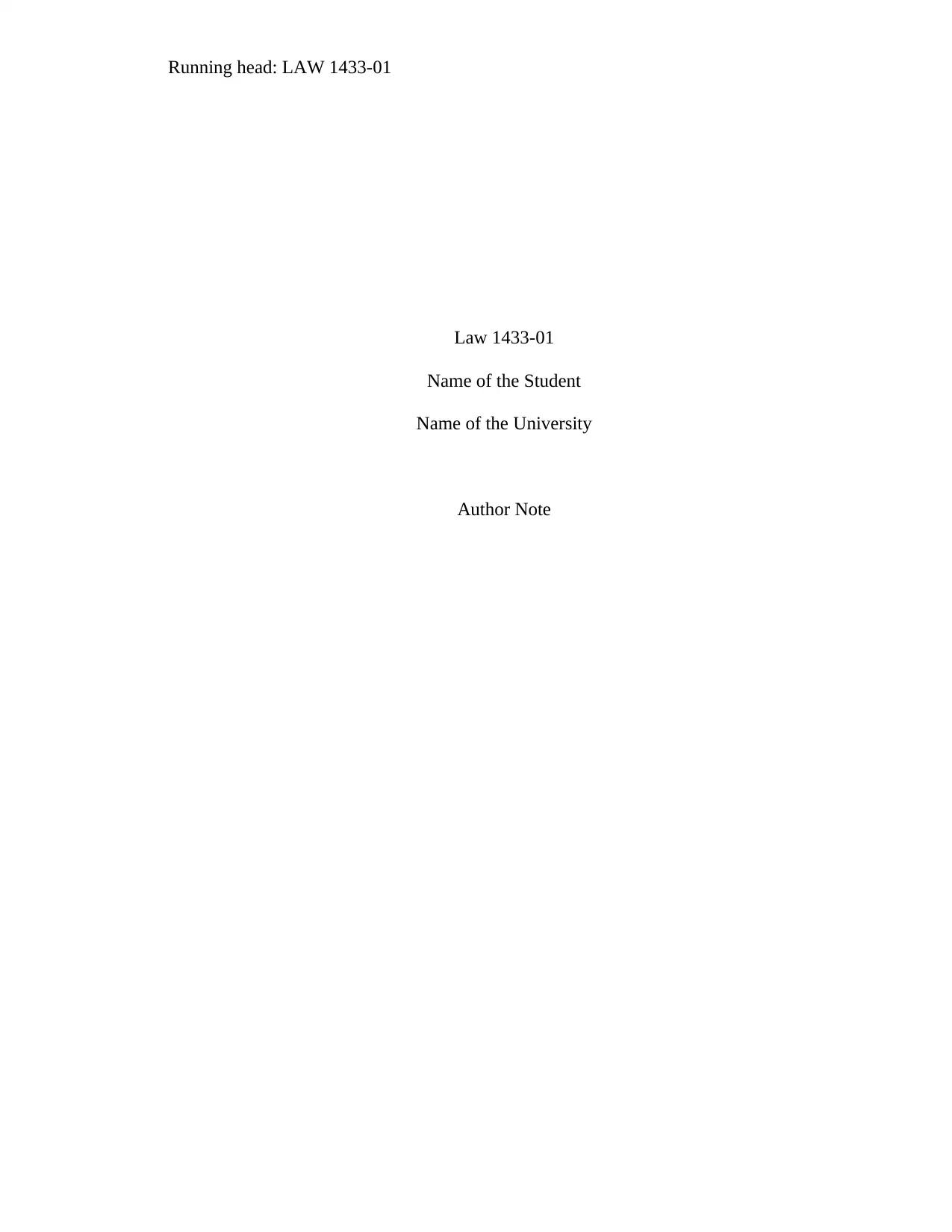
Running head: LAW 1433-01
Law 1433-01
Name of the Student
Name of the University
Author Note
Law 1433-01
Name of the Student
Name of the University
Author Note
Paraphrase This Document
Need a fresh take? Get an instant paraphrase of this document with our AI Paraphraser
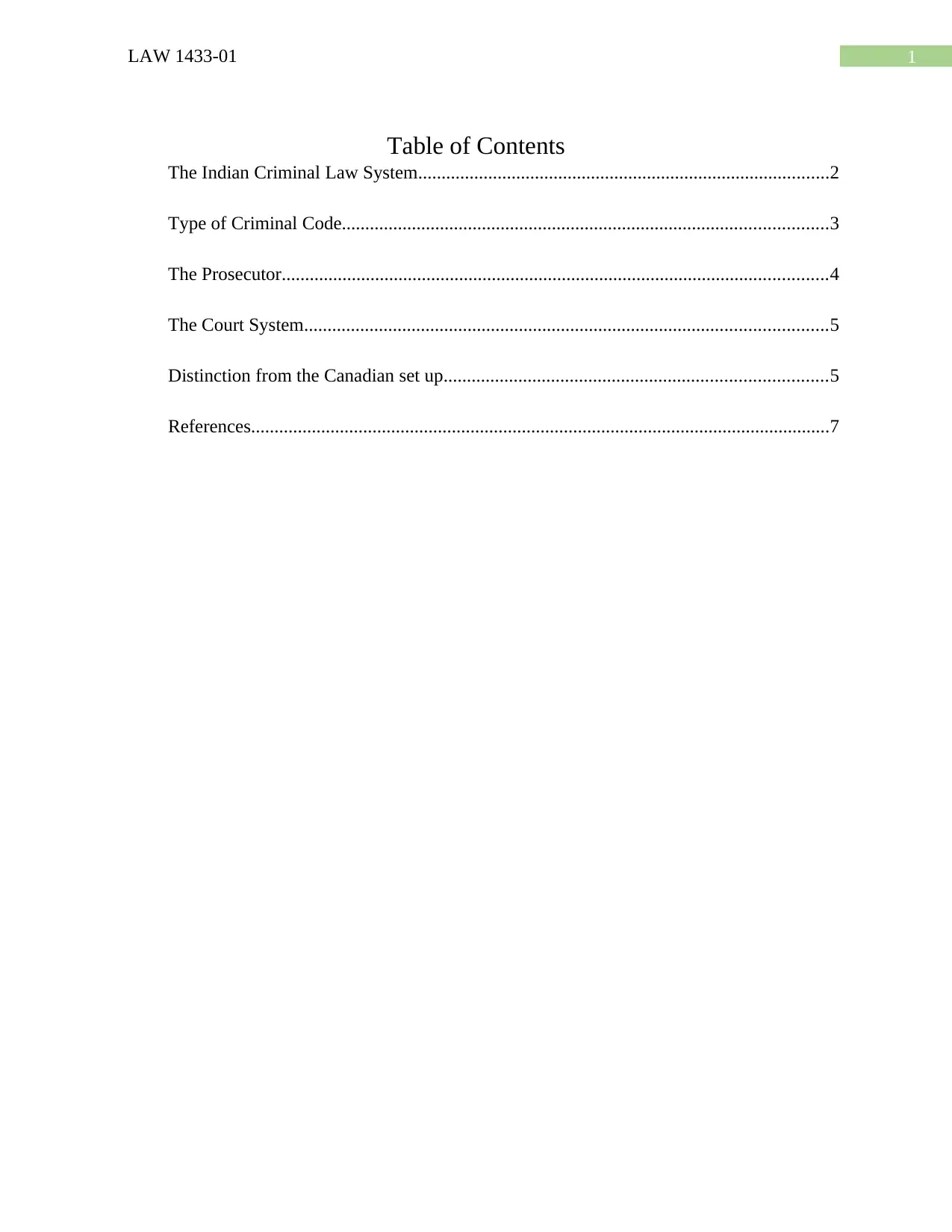
1LAW 1433-01
Table of Contents
The Indian Criminal Law System........................................................................................2
Type of Criminal Code........................................................................................................3
The Prosecutor.....................................................................................................................4
The Court System................................................................................................................5
Distinction from the Canadian set up..................................................................................5
References............................................................................................................................7
Table of Contents
The Indian Criminal Law System........................................................................................2
Type of Criminal Code........................................................................................................3
The Prosecutor.....................................................................................................................4
The Court System................................................................................................................5
Distinction from the Canadian set up..................................................................................5
References............................................................................................................................7
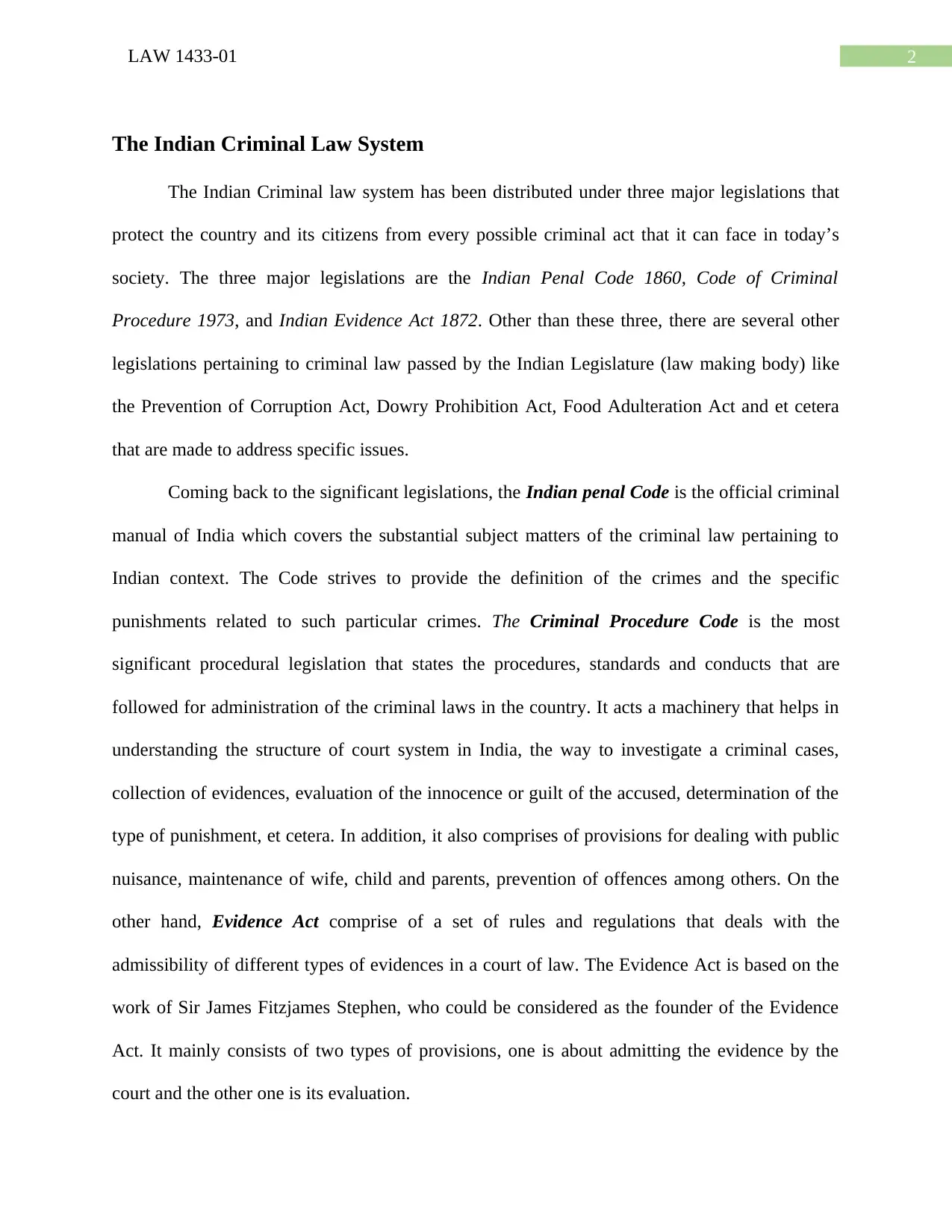
2LAW 1433-01
The Indian Criminal Law System
The Indian Criminal law system has been distributed under three major legislations that
protect the country and its citizens from every possible criminal act that it can face in today’s
society. The three major legislations are the Indian Penal Code 1860, Code of Criminal
Procedure 1973, and Indian Evidence Act 1872. Other than these three, there are several other
legislations pertaining to criminal law passed by the Indian Legislature (law making body) like
the Prevention of Corruption Act, Dowry Prohibition Act, Food Adulteration Act and et cetera
that are made to address specific issues.
Coming back to the significant legislations, the Indian penal Code is the official criminal
manual of India which covers the substantial subject matters of the criminal law pertaining to
Indian context. The Code strives to provide the definition of the crimes and the specific
punishments related to such particular crimes. The Criminal Procedure Code is the most
significant procedural legislation that states the procedures, standards and conducts that are
followed for administration of the criminal laws in the country. It acts a machinery that helps in
understanding the structure of court system in India, the way to investigate a criminal cases,
collection of evidences, evaluation of the innocence or guilt of the accused, determination of the
type of punishment, et cetera. In addition, it also comprises of provisions for dealing with public
nuisance, maintenance of wife, child and parents, prevention of offences among others. On the
other hand, Evidence Act comprise of a set of rules and regulations that deals with the
admissibility of different types of evidences in a court of law. The Evidence Act is based on the
work of Sir James Fitzjames Stephen, who could be considered as the founder of the Evidence
Act. It mainly consists of two types of provisions, one is about admitting the evidence by the
court and the other one is its evaluation.
The Indian Criminal Law System
The Indian Criminal law system has been distributed under three major legislations that
protect the country and its citizens from every possible criminal act that it can face in today’s
society. The three major legislations are the Indian Penal Code 1860, Code of Criminal
Procedure 1973, and Indian Evidence Act 1872. Other than these three, there are several other
legislations pertaining to criminal law passed by the Indian Legislature (law making body) like
the Prevention of Corruption Act, Dowry Prohibition Act, Food Adulteration Act and et cetera
that are made to address specific issues.
Coming back to the significant legislations, the Indian penal Code is the official criminal
manual of India which covers the substantial subject matters of the criminal law pertaining to
Indian context. The Code strives to provide the definition of the crimes and the specific
punishments related to such particular crimes. The Criminal Procedure Code is the most
significant procedural legislation that states the procedures, standards and conducts that are
followed for administration of the criminal laws in the country. It acts a machinery that helps in
understanding the structure of court system in India, the way to investigate a criminal cases,
collection of evidences, evaluation of the innocence or guilt of the accused, determination of the
type of punishment, et cetera. In addition, it also comprises of provisions for dealing with public
nuisance, maintenance of wife, child and parents, prevention of offences among others. On the
other hand, Evidence Act comprise of a set of rules and regulations that deals with the
admissibility of different types of evidences in a court of law. The Evidence Act is based on the
work of Sir James Fitzjames Stephen, who could be considered as the founder of the Evidence
Act. It mainly consists of two types of provisions, one is about admitting the evidence by the
court and the other one is its evaluation.
⊘ This is a preview!⊘
Do you want full access?
Subscribe today to unlock all pages.

Trusted by 1+ million students worldwide
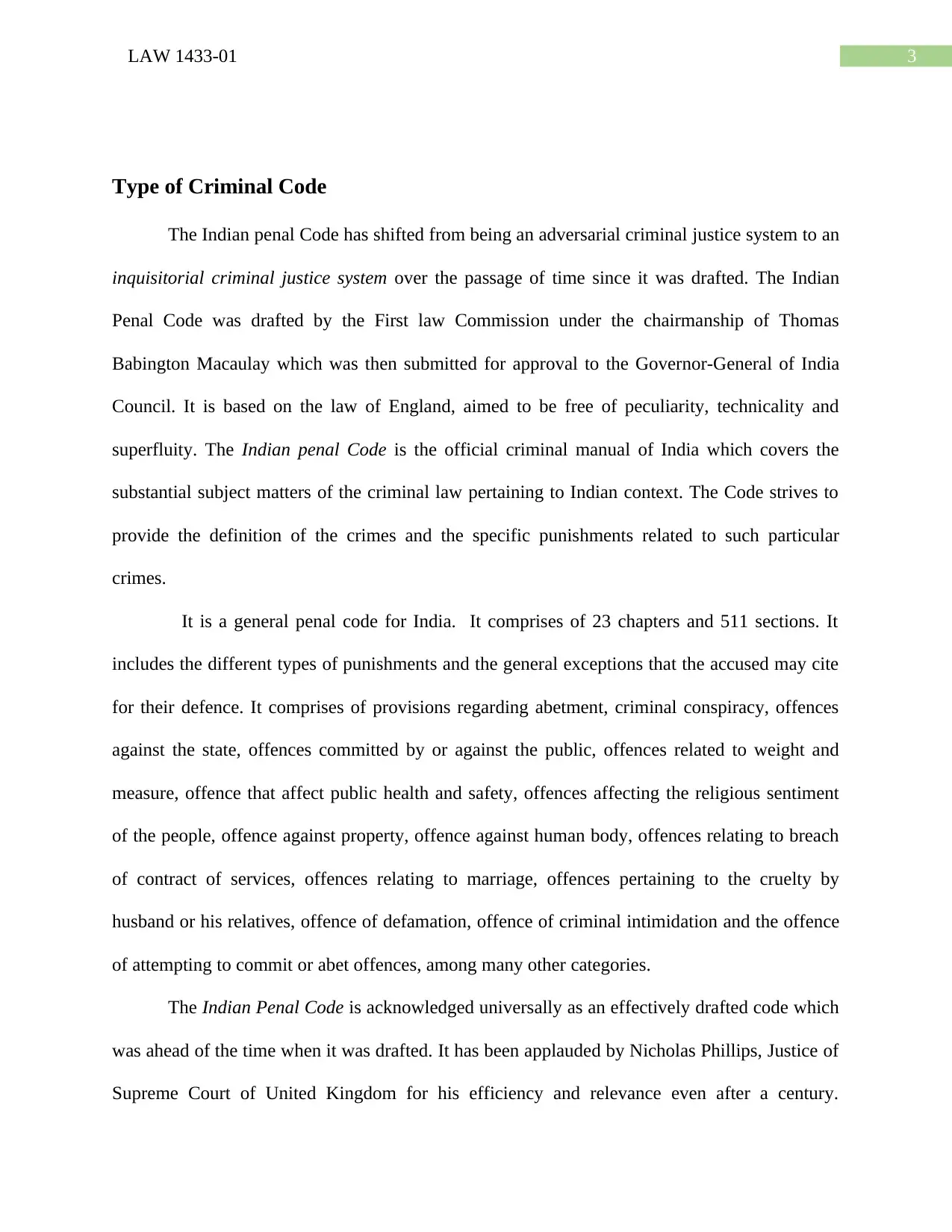
3LAW 1433-01
Type of Criminal Code
The Indian penal Code has shifted from being an adversarial criminal justice system to an
inquisitorial criminal justice system over the passage of time since it was drafted. The Indian
Penal Code was drafted by the First law Commission under the chairmanship of Thomas
Babington Macaulay which was then submitted for approval to the Governor-General of India
Council. It is based on the law of England, aimed to be free of peculiarity, technicality and
superfluity. The Indian penal Code is the official criminal manual of India which covers the
substantial subject matters of the criminal law pertaining to Indian context. The Code strives to
provide the definition of the crimes and the specific punishments related to such particular
crimes.
It is a general penal code for India. It comprises of 23 chapters and 511 sections. It
includes the different types of punishments and the general exceptions that the accused may cite
for their defence. It comprises of provisions regarding abetment, criminal conspiracy, offences
against the state, offences committed by or against the public, offences related to weight and
measure, offence that affect public health and safety, offences affecting the religious sentiment
of the people, offence against property, offence against human body, offences relating to breach
of contract of services, offences relating to marriage, offences pertaining to the cruelty by
husband or his relatives, offence of defamation, offence of criminal intimidation and the offence
of attempting to commit or abet offences, among many other categories.
The Indian Penal Code is acknowledged universally as an effectively drafted code which
was ahead of the time when it was drafted. It has been applauded by Nicholas Phillips, Justice of
Supreme Court of United Kingdom for his efficiency and relevance even after a century.
Type of Criminal Code
The Indian penal Code has shifted from being an adversarial criminal justice system to an
inquisitorial criminal justice system over the passage of time since it was drafted. The Indian
Penal Code was drafted by the First law Commission under the chairmanship of Thomas
Babington Macaulay which was then submitted for approval to the Governor-General of India
Council. It is based on the law of England, aimed to be free of peculiarity, technicality and
superfluity. The Indian penal Code is the official criminal manual of India which covers the
substantial subject matters of the criminal law pertaining to Indian context. The Code strives to
provide the definition of the crimes and the specific punishments related to such particular
crimes.
It is a general penal code for India. It comprises of 23 chapters and 511 sections. It
includes the different types of punishments and the general exceptions that the accused may cite
for their defence. It comprises of provisions regarding abetment, criminal conspiracy, offences
against the state, offences committed by or against the public, offences related to weight and
measure, offence that affect public health and safety, offences affecting the religious sentiment
of the people, offence against property, offence against human body, offences relating to breach
of contract of services, offences relating to marriage, offences pertaining to the cruelty by
husband or his relatives, offence of defamation, offence of criminal intimidation and the offence
of attempting to commit or abet offences, among many other categories.
The Indian Penal Code is acknowledged universally as an effectively drafted code which
was ahead of the time when it was drafted. It has been applauded by Nicholas Phillips, Justice of
Supreme Court of United Kingdom for his efficiency and relevance even after a century.
Paraphrase This Document
Need a fresh take? Get an instant paraphrase of this document with our AI Paraphraser
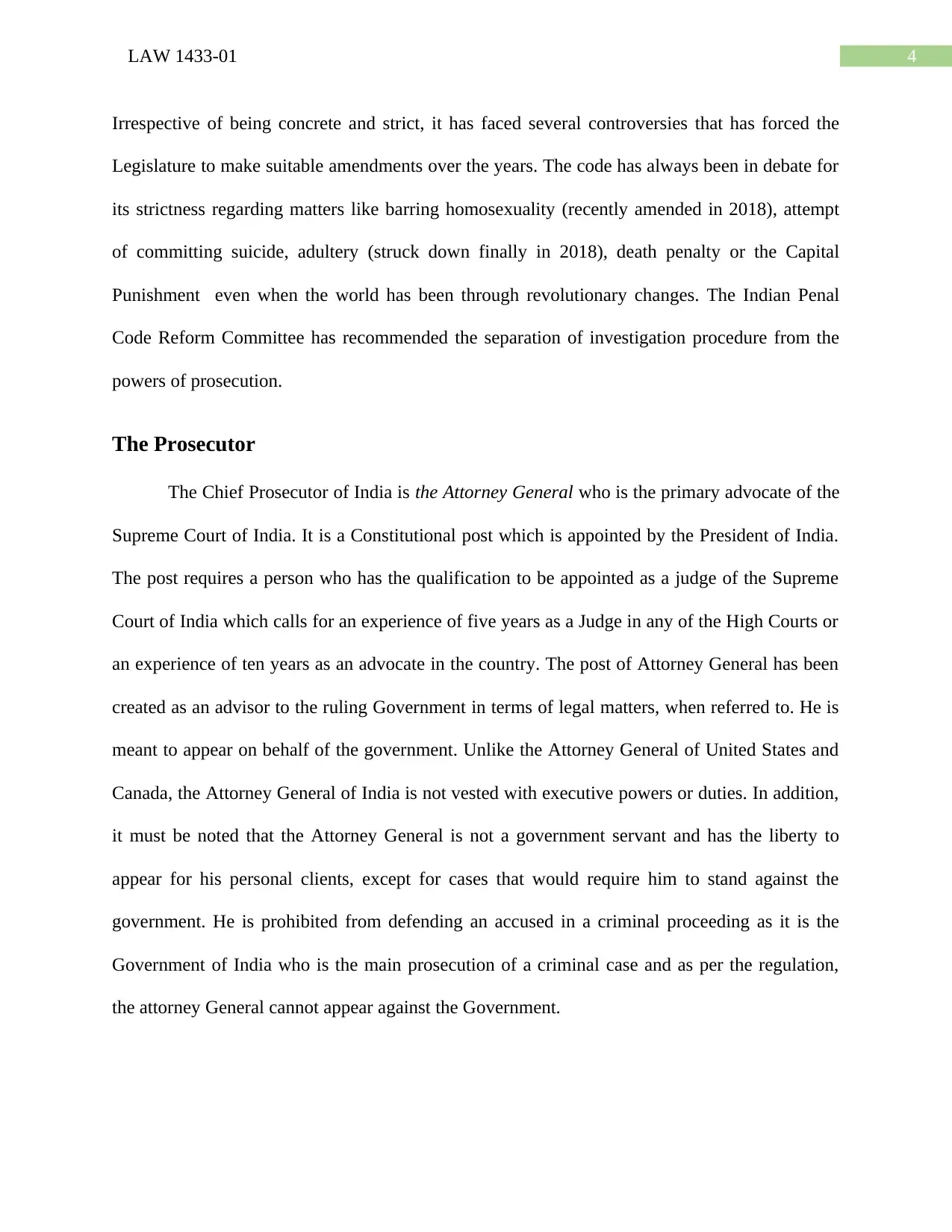
4LAW 1433-01
Irrespective of being concrete and strict, it has faced several controversies that has forced the
Legislature to make suitable amendments over the years. The code has always been in debate for
its strictness regarding matters like barring homosexuality (recently amended in 2018), attempt
of committing suicide, adultery (struck down finally in 2018), death penalty or the Capital
Punishment even when the world has been through revolutionary changes. The Indian Penal
Code Reform Committee has recommended the separation of investigation procedure from the
powers of prosecution.
The Prosecutor
The Chief Prosecutor of India is the Attorney General who is the primary advocate of the
Supreme Court of India. It is a Constitutional post which is appointed by the President of India.
The post requires a person who has the qualification to be appointed as a judge of the Supreme
Court of India which calls for an experience of five years as a Judge in any of the High Courts or
an experience of ten years as an advocate in the country. The post of Attorney General has been
created as an advisor to the ruling Government in terms of legal matters, when referred to. He is
meant to appear on behalf of the government. Unlike the Attorney General of United States and
Canada, the Attorney General of India is not vested with executive powers or duties. In addition,
it must be noted that the Attorney General is not a government servant and has the liberty to
appear for his personal clients, except for cases that would require him to stand against the
government. He is prohibited from defending an accused in a criminal proceeding as it is the
Government of India who is the main prosecution of a criminal case and as per the regulation,
the attorney General cannot appear against the Government.
Irrespective of being concrete and strict, it has faced several controversies that has forced the
Legislature to make suitable amendments over the years. The code has always been in debate for
its strictness regarding matters like barring homosexuality (recently amended in 2018), attempt
of committing suicide, adultery (struck down finally in 2018), death penalty or the Capital
Punishment even when the world has been through revolutionary changes. The Indian Penal
Code Reform Committee has recommended the separation of investigation procedure from the
powers of prosecution.
The Prosecutor
The Chief Prosecutor of India is the Attorney General who is the primary advocate of the
Supreme Court of India. It is a Constitutional post which is appointed by the President of India.
The post requires a person who has the qualification to be appointed as a judge of the Supreme
Court of India which calls for an experience of five years as a Judge in any of the High Courts or
an experience of ten years as an advocate in the country. The post of Attorney General has been
created as an advisor to the ruling Government in terms of legal matters, when referred to. He is
meant to appear on behalf of the government. Unlike the Attorney General of United States and
Canada, the Attorney General of India is not vested with executive powers or duties. In addition,
it must be noted that the Attorney General is not a government servant and has the liberty to
appear for his personal clients, except for cases that would require him to stand against the
government. He is prohibited from defending an accused in a criminal proceeding as it is the
Government of India who is the main prosecution of a criminal case and as per the regulation,
the attorney General cannot appear against the Government.
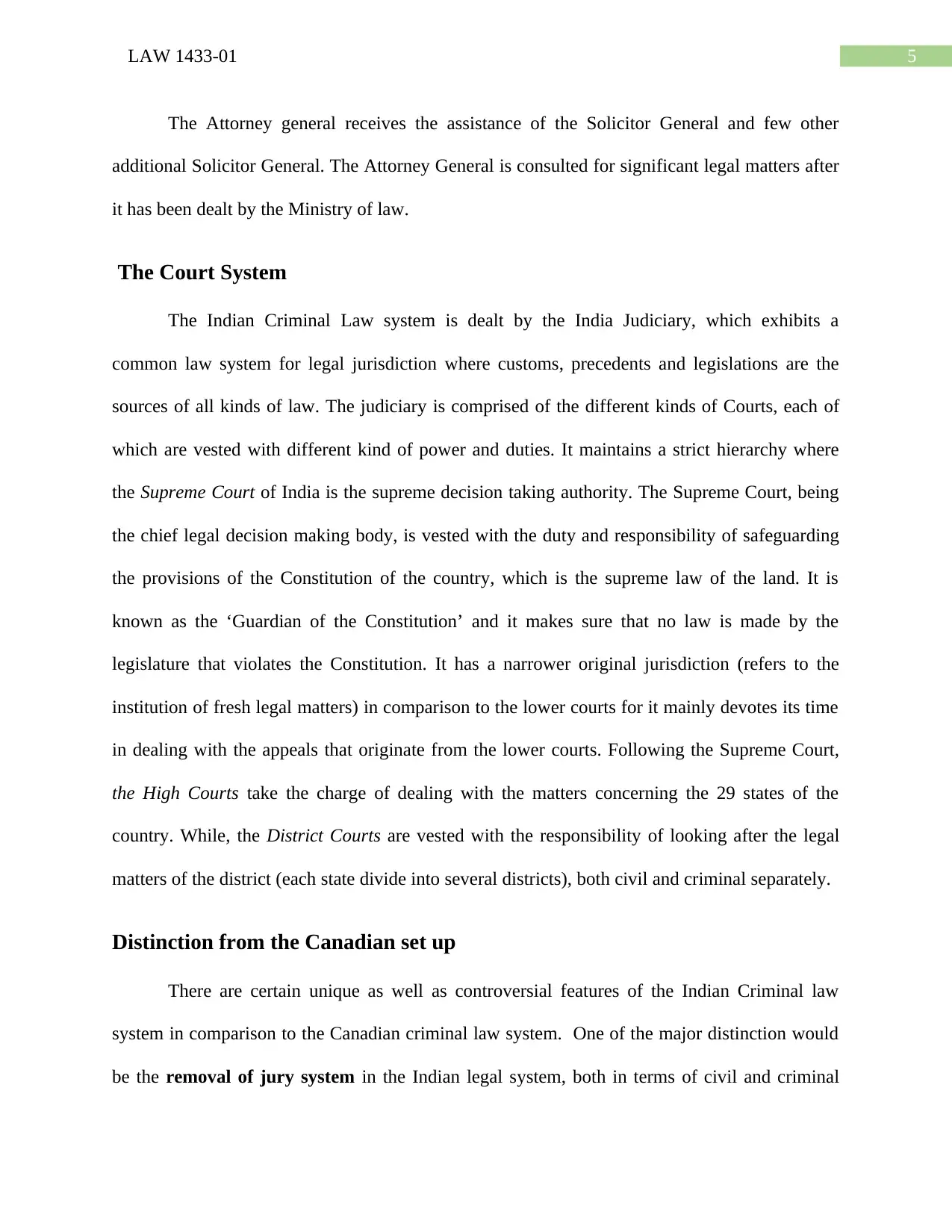
5LAW 1433-01
The Attorney general receives the assistance of the Solicitor General and few other
additional Solicitor General. The Attorney General is consulted for significant legal matters after
it has been dealt by the Ministry of law.
The Court System
The Indian Criminal Law system is dealt by the India Judiciary, which exhibits a
common law system for legal jurisdiction where customs, precedents and legislations are the
sources of all kinds of law. The judiciary is comprised of the different kinds of Courts, each of
which are vested with different kind of power and duties. It maintains a strict hierarchy where
the Supreme Court of India is the supreme decision taking authority. The Supreme Court, being
the chief legal decision making body, is vested with the duty and responsibility of safeguarding
the provisions of the Constitution of the country, which is the supreme law of the land. It is
known as the ‘Guardian of the Constitution’ and it makes sure that no law is made by the
legislature that violates the Constitution. It has a narrower original jurisdiction (refers to the
institution of fresh legal matters) in comparison to the lower courts for it mainly devotes its time
in dealing with the appeals that originate from the lower courts. Following the Supreme Court,
the High Courts take the charge of dealing with the matters concerning the 29 states of the
country. While, the District Courts are vested with the responsibility of looking after the legal
matters of the district (each state divide into several districts), both civil and criminal separately.
Distinction from the Canadian set up
There are certain unique as well as controversial features of the Indian Criminal law
system in comparison to the Canadian criminal law system. One of the major distinction would
be the removal of jury system in the Indian legal system, both in terms of civil and criminal
The Attorney general receives the assistance of the Solicitor General and few other
additional Solicitor General. The Attorney General is consulted for significant legal matters after
it has been dealt by the Ministry of law.
The Court System
The Indian Criminal Law system is dealt by the India Judiciary, which exhibits a
common law system for legal jurisdiction where customs, precedents and legislations are the
sources of all kinds of law. The judiciary is comprised of the different kinds of Courts, each of
which are vested with different kind of power and duties. It maintains a strict hierarchy where
the Supreme Court of India is the supreme decision taking authority. The Supreme Court, being
the chief legal decision making body, is vested with the duty and responsibility of safeguarding
the provisions of the Constitution of the country, which is the supreme law of the land. It is
known as the ‘Guardian of the Constitution’ and it makes sure that no law is made by the
legislature that violates the Constitution. It has a narrower original jurisdiction (refers to the
institution of fresh legal matters) in comparison to the lower courts for it mainly devotes its time
in dealing with the appeals that originate from the lower courts. Following the Supreme Court,
the High Courts take the charge of dealing with the matters concerning the 29 states of the
country. While, the District Courts are vested with the responsibility of looking after the legal
matters of the district (each state divide into several districts), both civil and criminal separately.
Distinction from the Canadian set up
There are certain unique as well as controversial features of the Indian Criminal law
system in comparison to the Canadian criminal law system. One of the major distinction would
be the removal of jury system in the Indian legal system, both in terms of civil and criminal
⊘ This is a preview!⊘
Do you want full access?
Subscribe today to unlock all pages.

Trusted by 1+ million students worldwide
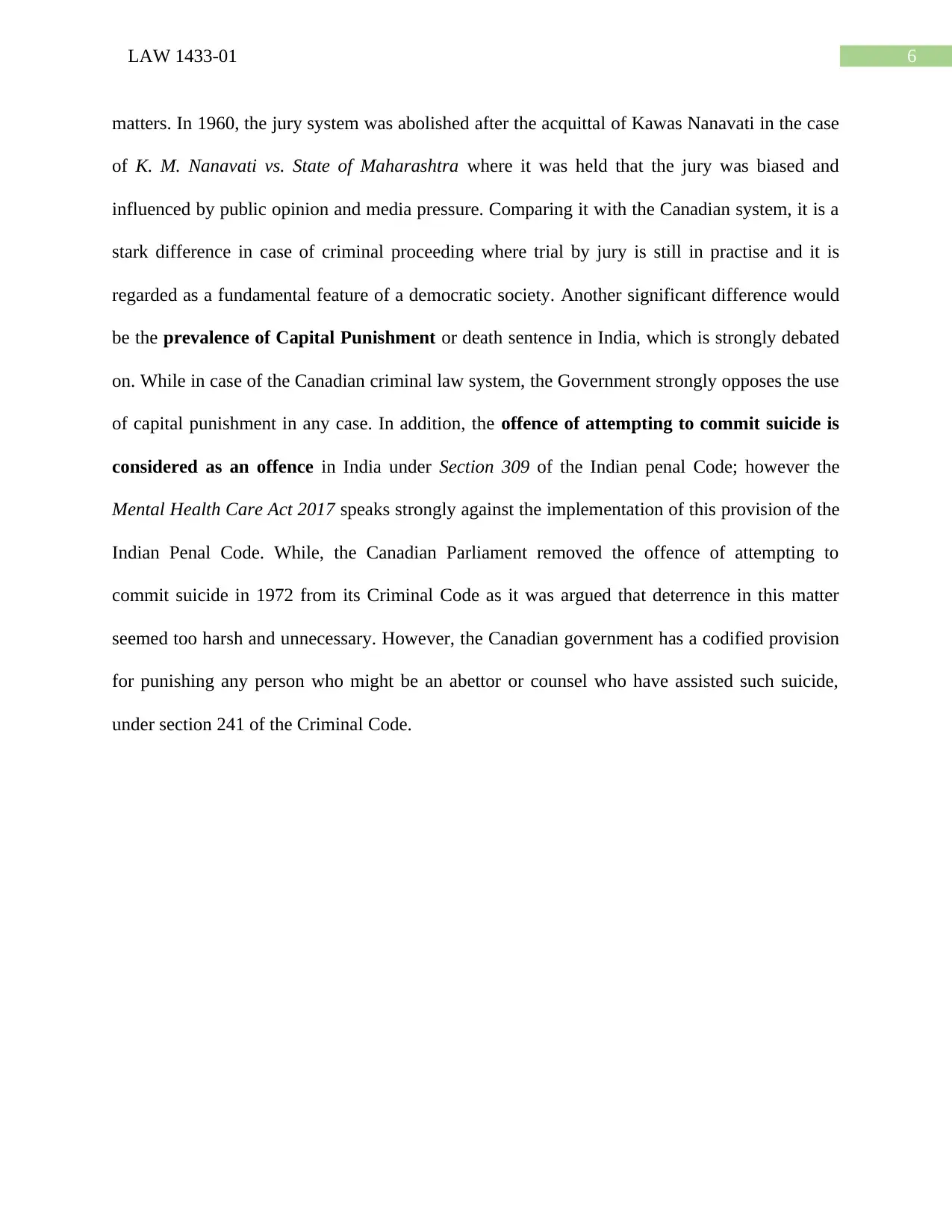
6LAW 1433-01
matters. In 1960, the jury system was abolished after the acquittal of Kawas Nanavati in the case
of K. M. Nanavati vs. State of Maharashtra where it was held that the jury was biased and
influenced by public opinion and media pressure. Comparing it with the Canadian system, it is a
stark difference in case of criminal proceeding where trial by jury is still in practise and it is
regarded as a fundamental feature of a democratic society. Another significant difference would
be the prevalence of Capital Punishment or death sentence in India, which is strongly debated
on. While in case of the Canadian criminal law system, the Government strongly opposes the use
of capital punishment in any case. In addition, the offence of attempting to commit suicide is
considered as an offence in India under Section 309 of the Indian penal Code; however the
Mental Health Care Act 2017 speaks strongly against the implementation of this provision of the
Indian Penal Code. While, the Canadian Parliament removed the offence of attempting to
commit suicide in 1972 from its Criminal Code as it was argued that deterrence in this matter
seemed too harsh and unnecessary. However, the Canadian government has a codified provision
for punishing any person who might be an abettor or counsel who have assisted such suicide,
under section 241 of the Criminal Code.
matters. In 1960, the jury system was abolished after the acquittal of Kawas Nanavati in the case
of K. M. Nanavati vs. State of Maharashtra where it was held that the jury was biased and
influenced by public opinion and media pressure. Comparing it with the Canadian system, it is a
stark difference in case of criminal proceeding where trial by jury is still in practise and it is
regarded as a fundamental feature of a democratic society. Another significant difference would
be the prevalence of Capital Punishment or death sentence in India, which is strongly debated
on. While in case of the Canadian criminal law system, the Government strongly opposes the use
of capital punishment in any case. In addition, the offence of attempting to commit suicide is
considered as an offence in India under Section 309 of the Indian penal Code; however the
Mental Health Care Act 2017 speaks strongly against the implementation of this provision of the
Indian Penal Code. While, the Canadian Parliament removed the offence of attempting to
commit suicide in 1972 from its Criminal Code as it was argued that deterrence in this matter
seemed too harsh and unnecessary. However, the Canadian government has a codified provision
for punishing any person who might be an abettor or counsel who have assisted such suicide,
under section 241 of the Criminal Code.
Paraphrase This Document
Need a fresh take? Get an instant paraphrase of this document with our AI Paraphraser
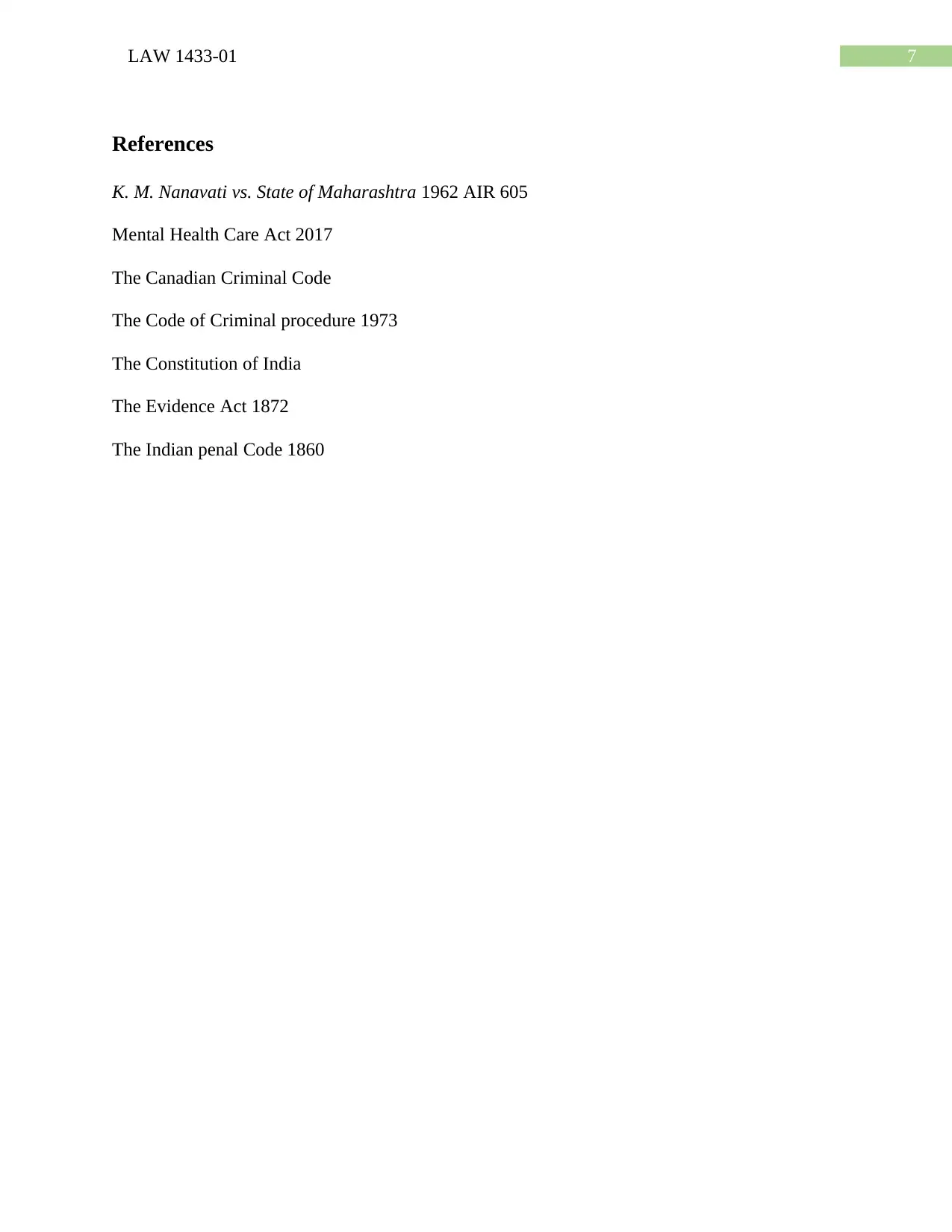
7LAW 1433-01
References
K. M. Nanavati vs. State of Maharashtra 1962 AIR 605
Mental Health Care Act 2017
The Canadian Criminal Code
The Code of Criminal procedure 1973
The Constitution of India
The Evidence Act 1872
The Indian penal Code 1860
References
K. M. Nanavati vs. State of Maharashtra 1962 AIR 605
Mental Health Care Act 2017
The Canadian Criminal Code
The Code of Criminal procedure 1973
The Constitution of India
The Evidence Act 1872
The Indian penal Code 1860
1 out of 8
Related Documents
Your All-in-One AI-Powered Toolkit for Academic Success.
+13062052269
info@desklib.com
Available 24*7 on WhatsApp / Email
![[object Object]](/_next/static/media/star-bottom.7253800d.svg)
Unlock your academic potential
Copyright © 2020–2025 A2Z Services. All Rights Reserved. Developed and managed by ZUCOL.


